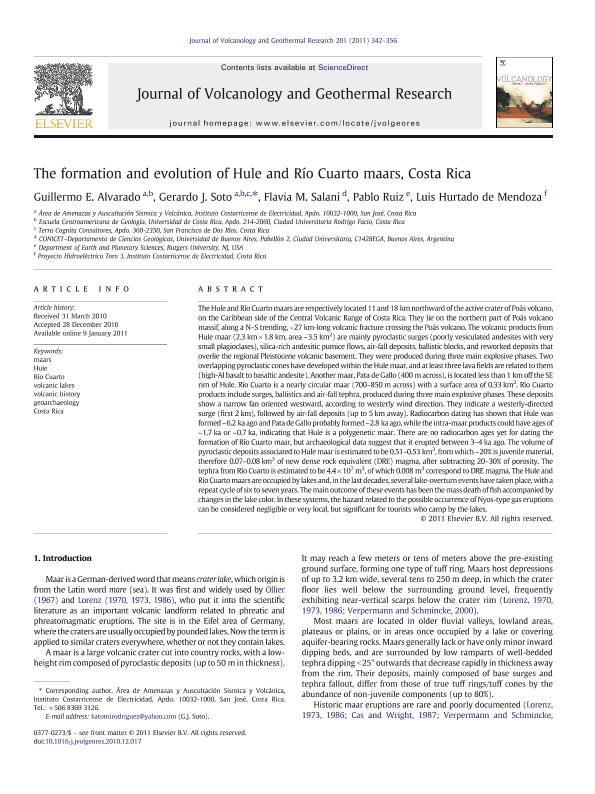Artículo
The formation and evolution of Hule and Río Cuarto maars, Costa Rica
Alvarado, Guillermo E.; Soto, Gerardo J.; Salani, Flavia Maria ; Ruiz, Pablo; Hurtado de Mendoza, Luis
; Ruiz, Pablo; Hurtado de Mendoza, Luis
 ; Ruiz, Pablo; Hurtado de Mendoza, Luis
; Ruiz, Pablo; Hurtado de Mendoza, Luis
Fecha de publicación:
04/2011
Editorial:
Elsevier Science
Revista:
Journal of Volcanology and Geothermal Research
ISSN:
0377-0273
Idioma:
Inglés
Tipo de recurso:
Artículo publicado
Clasificación temática:
Resumen
The Hule and Río Cuarto maars are respectively located 11 and 18km northward of the active crater of Poás volcano, on the Caribbean side of the Central Volcanic Range of Costa Rica. They lie on the northern part of Poás volcano massif, along a N-S trending, ~27km-long volcanic fracture crossing the Poás volcano. The volcanic products from Hule maar (2.3km×1.8km, area ~3.5km2) are mainly pyroclastic surges (poorly vesiculated andesites with very small plagioclases), silica-rich andesitic pumice flows, air-fall deposits, ballistic blocks, and reworked deposits that overlie the regional Pleistocene volcanic basement. They were produced during three main explosive phases. Two overlapping pyroclastic cones have developed within the Hule maar, and at least three lava fields are related to them (high-Al basalt to basaltic andesite). Another maar, Pata de Gallo (400m across), is located less than 1km off the SE rim of Hule. Río Cuarto is a nearly circular maar (700-850m across) with a surface area of 0.33km2. Río Cuarto products include surges, ballistics and air-fall tephra, produced during three main explosive phases. These deposits show a narrow fan oriented westward, according to westerly wind direction. They indicate a westerly-directed surge (first 2km), followed by air-fall deposits (up to 5km away). Radiocarbon dating has shown that Hule was formed ~6.2ka ago and Pata de Gallo probably formed ~2.8ka ago, while the intra-maar products could have ages of ~1.7ka or ~0.7ka, indicating that Hule is a polygenetic maar. There are no radiocarbon ages yet for dating the formation of Río Cuarto maar, but archaeological data suggest that it erupted between 3-4ka ago. The volume of pyroclastic deposits associated to Hule maar is estimated to be 0.51-0.53km3, from which ~20% is juvenile material, therefore 0.07-0.08km3 of new dense rock equivalent (DRE) magma, after subtracting 20-30% of porosity. The tephra from Río Cuarto is estimated to be 4.4×107m3, of which 0.008m3 correspond to DRE magma. The Hule and Río Cuarto maars are occupied by lakes and, in the last decades, several lake-overturn events have taken place, with a repeat cycle of six to seven years. The main outcome of these events has been the mass death of fish accompanied by changes in the lake color. In these systems, the hazard related to the possible occurrence of Nyos-type gas eruptions can be considered negligible or very local, but significant for tourists who camp by the lakes.
Archivos asociados
Licencia
Identificadores
Colecciones
Articulos(IGEBA)
Articulos de INSTITUTO DE GEOCIENCIAS BASICAS, APLICADAS Y AMBIENTALES DE BS. AS
Articulos de INSTITUTO DE GEOCIENCIAS BASICAS, APLICADAS Y AMBIENTALES DE BS. AS
Citación
Alvarado, Guillermo E.; Soto, Gerardo J.; Salani, Flavia Maria; Ruiz, Pablo; Hurtado de Mendoza, Luis; The formation and evolution of Hule and Río Cuarto maars, Costa Rica; Elsevier Science; Journal of Volcanology and Geothermal Research; 201; 1-4; 4-2011; 342-356
Compartir
Altmétricas



